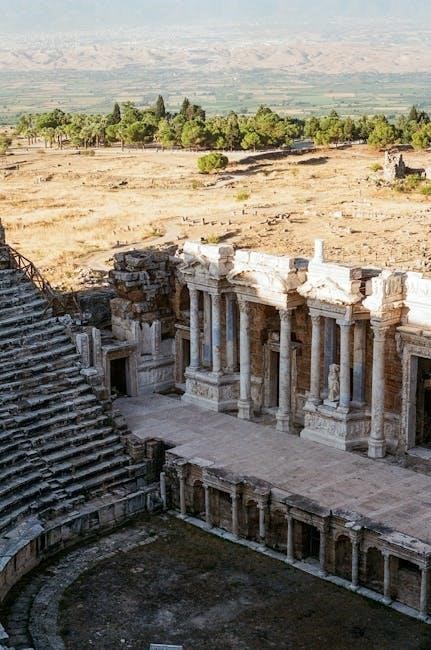This world history textbook for 10th grade provides a comprehensive exploration of global events from 1500 to the present, offering a free PDF format for easy access and OER-supported learning.
1.1 Overview of the Curriculum
The curriculum spans world history from 1500 to the present, divided into 15 chapters. It emphasizes critical thinking, global perspectives, and the integration of primary and secondary sources. Designed for 10th-grade students, the course explores cultural interactions, historical developments, and contemporary issues. The structured approach helps students connect past events to modern contexts, fostering a deeper understanding of global processes and their impact on societies. Multimedia resources and inquiry-based projects enhance engagement, making history relevant and accessible for learners.
1.2 Key Features of the Textbook
This 10th-grade world history textbook is available as a free PDF, offering flexible digital access. It integrates primary and secondary sources, multimedia features, and inquiry-based learning projects. The curriculum aligns with educational standards like Common Core and AP World History, ensuring rigorous academic preparation. Interactive elements, such as streaming videos and global perspectives, engage students and promote critical thinking; Customization options allow teachers to tailor content, while supplementary worksheets and study guides support student success. The textbook emphasizes cultural diversity and global connections, making it a versatile and comprehensive resource.
1.3 Importance of Digital Accessibility (PDF Format)
The PDF format enhances accessibility, enabling students to access the 10th-grade world history textbook anytime, anywhere. Digital features like search and zoom improve readability, while compatibility with assistive technologies supports diverse learning needs. The portable format allows easy sharing and printing, reducing barriers to education. By offering a free and downloadable resource, it ensures equity in access, making high-quality historical content available to all students, regardless of their location or technological setup.

Historical Periods Covered
The textbook spans the Modern Era (1500 to present), covering the 19th and 20th centuries’ nationalism and imperialism, and extending to contemporary global issues of the 21st century.
2.1 The Modern Era (1500 to Present)
The Modern Era explores global transformations from 1500 to today, emphasizing globalization, technological advancements, and cultural exchanges. This period highlights the rise of nation-states, industrialization, and the impact of colonialism. The textbook examines key events like the Enlightenment, World Wars, and the Cold War, offering insights into how these developments shaped modern societies; By integrating primary sources and a global perspective, students gain a deeper understanding of the interconnectedness of historical processes and their relevance to contemporary issues.
2.2 19th and 20th Centuries: Nationalism and Imperialism
The 19th and 20th centuries were marked by the rise of nationalism and imperialism, reshaping global politics and societies. Nationalist movements led to the unification of nations like Germany and Italy, while imperial powers expanded their territories, impacting colonies worldwide. The textbook explores how these ideologies fueled conflicts, including World War I and II, and examines their lasting effects on global power dynamics and cultural identities. This period highlights the tension between self-determination and domination, shaping the modern world.
2.3 Contemporary Issues in World History
The textbook examines contemporary issues shaping the modern world, such as globalization, technological advancements, and cultural exchanges. It explores challenges like climate change, economic inequality, and political conflicts, emphasizing their historical roots. Students gain insights into how past events influence current global dynamics, fostering a deeper understanding of the interconnectedness of nations and the relevance of history in addressing modern problems. This section encourages critical thinking about the complexities of the 21st century and their impact on future societies.

Structure and Organization
The textbook is organized into 15 chapters, each focusing on key periods and themes in world history. Units are divided into sections with clear objectives, primary sources, and engaging activities, ensuring a logical flow of content. The structure promotes a chronological and thematic understanding, making it easy for 10th-grade students to follow and connect historical events across different regions and eras.
3.1 Chapter Breakdown and Unit Organization
The textbook is divided into 15 chapters, each covering distinct periods and themes in world history. Units are structured chronologically, with each chapter containing sub-units that focus on specific regions, events, and cultural developments. Key features include unit introductions, primary source excerpts, and interactive elements to enhance understanding. The organization ensures a logical progression from the early modern era to contemporary issues, providing students with a coherent framework to analyze historical patterns and global connections. This structure supports both thematic and chronological learning, making it ideal for 10th-grade students.
3.2 Integration of Primary and Secondary Sources
The textbook seamlessly integrates primary and secondary sources to enrich learning. Primary sources, such as historical documents, images, and excerpts, provide firsthand insights into events. Secondary sources, like scholarly analyses, offer context and interpretation. Together, they encourage critical thinking and analysis. Students engage with diverse perspectives, connecting historical narratives to contemporary issues. This approach fosters a deeper understanding of global processes and cultural interactions, making history relatable and accessible for 10th-grade students.
3.3 Focus on Global Perspectives
The textbook emphasizes global perspectives to highlight interconnectedness across regions. By exploring diverse cultures, geographical influences, and historical events, students gain a holistic view of world history. This approach encourages empathy and understanding of how global processes have shaped civilizations. The integration of case studies from around the world further enriches the narrative, helping students appreciate the complexity of historical developments and their relevance to contemporary issues.

Teaching and Learning Resources
The textbook offers comprehensive resources, including lesson plans, interactive features, and supplementary worksheets, designed to support teachers and engage students in a dynamic learning experience.
4.1 Lesson Plans for 10th Grade World History
Engaging lesson plans are tailored for 10th-grade students, covering key historical periods and global events. These plans integrate inquiry-based learning, fostering critical thinking and analysis. Resources include structured activities, primary source analysis, and multimedia tools to enhance understanding. Designed to align with educational standards like AP World History and Common Core, these plans provide teachers with flexible and comprehensive frameworks to deliver impactful instruction.

4.2 Interactive Features and Multimedia
The textbook incorporates interactive features such as videos, maps, and timelines to enhance student engagement. Multimedia elements like primary source analysis and audio narratives bring historical events to life. These tools are designed to foster a deeper understanding of global processes and cultural interactions. Interactive features also include quizzes and simulations, allowing students to test their knowledge and apply critical thinking skills in a dynamic learning environment.
4.4 Supplementary Worksheets and Study Guides
Supplementary worksheets and study guides are provided to reinforce learning objectives and deepen understanding of key historical concepts. These resources include interactive activities, map exercises, and primary source analyses. Designed to align with curriculum standards, the worksheets cater to diverse learning styles, offering structured exercises for critical thinking and reflection. Study guides summarize essential content, while review questions help students prepare for assessments. These materials are accessible in PDF format, ensuring flexibility for both teachers and students. They are organized by chapter, making it easy to track progress and reinforce classroom instruction.

Key Themes and Concepts
The textbook explores globalization, cultural exchange, and technological advancements, emphasizing their interconnectedness across historical periods. Themes like nationalism, imperialism, and global processes are central to the curriculum.
5.1 Patterns of Interaction and Global Processes
The textbook examines how societies have interacted over time, focusing on trade networks, cultural diffusion, and conflict. It highlights globalization’s role in shaping societies, emphasizing technological advancements, social movements, and political ideologies. Students explore how global processes, such as imperialism and industrialization, influenced cultural and economic exchanges. The curriculum encourages critical thinking about the interconnectedness of human experiences and the impact of historical events on modern global systems, fostering a deeper understanding of worldwide interdependence.
5.2 Development of Human Interaction and Civilizations
This section explores the evolution of human societies, tracing the emergence of civilizations from early agricultural communities to complex urban centers. Key developments such as trade, technology, and governance are highlighted, showing how these factors shaped cultural and social structures. The textbook emphasizes the role of innovation, migration, and environmental adaptation in fostering civilizations like Mesopotamia, Egypt, China, and the Indus Valley. By examining these foundational societies, students gain insights into the roots of modern human interaction and cultural diversity.
5.3 Historical Narratives and Critical Thinking
The textbook emphasizes the importance of historical narratives in shaping our understanding of the past. By analyzing primary and secondary sources, students develop critical thinking skills to interpret events, cultures, and ideas. The curriculum encourages reflective learning through inquiry-based projects, helping students connect historical themes to contemporary issues. This approach fosters a deeper comprehension of how historical events have influenced modern societies, cultures, and technologies, preparing students to engage thoughtfully with the complexities of the present and future.

Alignment with Educational Standards
The textbook aligns with Common Core and AP standards, integrating critical thinking and global perspectives to meet educational goals for 10th-grade world history curricula effectively.
6.1 Common Core Standards for History/Social Studies
The textbook adheres to Common Core standards, emphasizing critical analysis of primary and secondary sources, chronological reasoning, and evidence-based arguments. It supports 10th-grade students in developing historical thinking skills, aligning with RH.9-10.1, which requires citing textual evidence. By integrating these standards, the curriculum ensures students can evaluate sources, identify perspectives, and construct well-supported interpretations of historical events, fostering a deeper understanding of world history and its relevance to contemporary issues.
6.2 National Geographic Learning Resources

National Geographic Learning Resources enhance the world history textbook by providing a global perspective through historical overviews, contemporary explorers, and photographers. These resources integrate interactive features and streaming video to bring history to life. They help students connect the past and present, fostering critical thinking and reflection. The program’s enhanced HISTORY curriculum motivates students to engage deeply with content, making learning both practical and inspiring for 10th-grade world history studies.
6.3 AP World History Curriculum Alignment
The world history textbook is meticulously aligned with the AP World History curriculum, covering essential periods from 1500 to the present. It emphasizes key themes such as patterns of interaction, global processes, and historical narratives, ensuring a comprehensive understanding of world civilizations and their development over time.
By integrating primary and secondary sources, the textbook supports critical thinking and analysis, preparing students for AP exams. Its structured approach aligns with AP learning objectives, fostering a deep engagement with historical content and global perspectives.
Open Educational Resources (OER)
OER provides free, adaptable, and high-quality educational materials, including the world history textbook in PDF format, enabling equitable access for all learners and fostering collaborative learning environments.
7.1 Benefits of OER in History Education
The integration of OER in history education offers numerous benefits, including free access to high-quality materials like the world history textbook in PDF format. OER promotes equity by ensuring all students can access learning resources regardless of financial means. It also encourages customization, allowing teachers to adapt content to meet specific curriculum needs or student interests. Additionally, OER materials often incorporate diverse perspectives, primary sources, and multimedia, enriching the learning experience. This approach fosters collaborative learning and supports the development of critical thinking skills in students. By leveraging OER, educators can create engaging and inclusive history lessons that align with educational standards while remaining adaptable to evolving teaching practices. This makes OER a valuable resource for modern history education, particularly at the 10th-grade level, where foundational understanding and analytical skills are crucial.
7.2 Accessing the Textbook as a PDF
The world history textbook is easily accessible in PDF format, providing flexibility for both teachers and students. Digital versions allow users to download or view the content online, ensuring convenience and portability. The PDF format maintains consistent layout and quality across devices, making it ideal for interactive features and multimedia integration. This accessibility supports self-paced learning and enables educators to distribute materials efficiently, catering to diverse learning environments and preferences. The PDF version also facilitates easy searching, bookmarking, and annotation, enhancing the overall learning experience for 10th-grade students.
7.3 Customization Options for Teachers
The world history textbook offers flexible customization options for educators, allowing adaptation to specific teaching methods and classroom needs. Teachers can modify lesson plans, incorporate supplementary materials, and integrate primary and secondary sources to enhance engagement. The PDF format enables easy annotation and sharing of customized content, while OER tools provide additional resources for tailored instruction. This adaptability ensures the curriculum remains relevant and effective, supporting diverse teaching approaches and student learning styles in the 10th-grade classroom.

Student Engagement and Participation
The world history textbook encourages active learning through inquiry-based projects, critical reflection, and interactive features, fostering meaningful connections between historical events and students’ real-world experiences.
8.1 Inquiry-Based Learning Projects
Inquiry-based learning projects place students at the center of exploration, fostering critical thinking and collaboration. Each unit begins with an open-ended question, encouraging students to investigate historical themes through diverse sources and perspectives. This approach aligns with National Geographic Learning, which emphasizes global awareness and the integration of contemporary explorers’ insights. By engaging with real-world issues and historical narratives, students develop a deeper understanding of global processes and their relevance to modern society, making history more accessible and meaningful.
8.2 Encouraging Critical Reflection and Analysis
The textbook incorporates activities that prompt students to reflect on historical events and analyze their significance. By examining primary sources, such as documents and images, students develop the ability to evaluate evidence and form well-supported arguments. This focus on critical reflection aligns with Common Core Standards, ensuring students can interpret complex texts and connect historical themes to contemporary issues. Such skills not only enhance academic performance but also prepare students for lifelong learning and informed civic engagement.
8.3 Connecting Past and Present
The textbook emphasizes linking historical events to modern-day issues, fostering a deeper understanding of continuity and change. By exploring how past developments influence current global challenges, students gain a nuanced perspective on topics like nationalism, imperialism, and cultural interactions. This approach encourages students to think critically about the relevance of history in shaping contemporary society, promoting a connection between the curriculum and real-world applications.

Cultural and Geographical Contexts
The textbook explores diverse cultures and regions, highlighting geographical influences on historical events. Case studies from around the world provide insights into cultural interactions and global perspectives.
9.1 Exploring Diverse Cultures and Regions
The textbook delves into the rich tapestry of cultures worldwide, examining their traditions, values, and contributions to global history. By focusing on specific regions, students gain a deeper understanding of how cultural diversity has shaped historical events and contemporary societies. Interactive features and case studies enhance this exploration, allowing learners to connect with the experiences of different civilizations firsthand.
9.2 Geographical Influences on Historical Events
Geography has played a pivotal role in shaping historical events, as highlighted in the textbook. Natural resources, climate, and territorial boundaries have influenced empires, trade routes, and conflicts. For instance, the abundance of resources in certain regions drove colonialism and imperialism, while geographical barriers often dictated the outcomes of battles. The textbook uses maps and case studies to illustrate how physical landscapes have been both opportunities and challenges throughout history.
9.3 case Studies from Around the World
9.3 Case Studies from Around the World
The textbook incorporates diverse case studies from regions like Asia, Europe, Africa, and the Americas, offering insights into unique historical experiences. These studies explore events such as the Roman Empire’s expansion, the Mongol Empire’s global impact, and the Industrial Revolution’s societal transformations. By examining these examples, students gain a deeper understanding of cultural, political, and economic interactions that shaped global history. These case studies also highlight how local events influenced broader historical trends, fostering a more nuanced perspective on the past.
This world history textbook concludes by emphasizing the importance of understanding global interactions and cultural diversity, inspiring students to connect historical events with contemporary issues and fostering lifelong learning.
10.1 Summary of Key Takeaways
The world history textbook for 10th grade emphasizes global interactions, cultural diversity, and historical narratives from 1500 to the present; It integrates primary and secondary sources, fostering critical thinking and analysis. The curriculum aligns with educational standards, promoting inquiry-based learning and digital accessibility through PDF formats. By connecting past events to contemporary issues, the textbook encourages students to develop a global perspective and apply historical knowledge to real-world challenges, inspiring lifelong learning and intellectual curiosity about our shared human experience.
10.2 The Role of History in Shaping the Future
Understanding world history is crucial for shaping the future, as it provides insights into past patterns, cultural evolution, and global interactions. By analyzing historical events, students can predict future trends, make informed decisions, and appreciate the diversity of human experiences. The 10th grade PDF textbook emphasizes critical thinking and reflection, enabling learners to apply historical lessons to contemporary challenges. This fosters a deeper understanding of how past events influence present and future societies, preparing students to engage thoughtfully with global issues. History thus serves as a foundation for building a more informed and equitable world.
10.3 Encouraging Lifelong Learning in History
The world history textbook for 10th grade fosters a love for learning by presenting history as a dynamic and interconnected field. Its PDF format ensures accessibility, allowing students to explore historical narratives anytime, anywhere. By integrating primary sources, interactive features, and global perspectives, the textbook encourages students to think critically and develop a deeper appreciation for history. This foundation inspires learners to pursue historical inquiry beyond the classroom, making history a lifelong passion that enriches their understanding of the world and its complexities.
